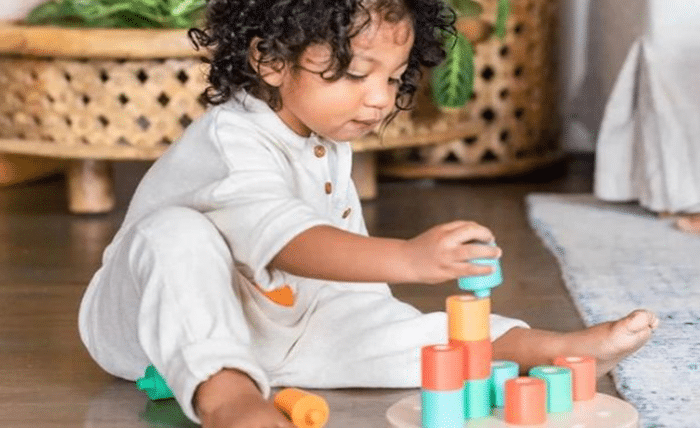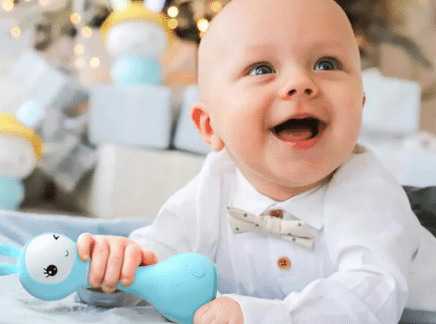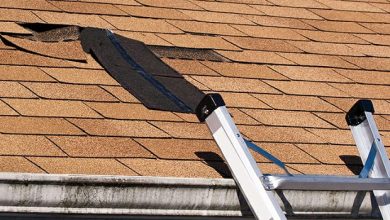
Fine motor skills are the foundation of a baby’s ability to interact with the world. These small, precise movements—like picking up a Cheerio, turning a page in a board book, or holding a spoon—develop gradually through play and exploration. Strong fine motor skills lead to greater independence, better hand-eye coordination, and even early writing readiness. Parents often wonder how to support this development naturally. The answer lies in choosing the right toys that encourage grasping, squeezing, and manipulating objects. Even simple interactions, like handing a baby a soft block or letting them explore a textured ball, help strengthen their tiny hand muscles. In this article, we’ll explore the best toys for fine motor development and how they support key milestones.
When Do Fine Motor Skills Develop?
Key Milestones: From Newborn Grasps to Toddler Precision
Babies begin developing fine motor skills from birth, starting with reflexive grasps. In the first few months, they instinctively clutch fingers or small objects placed in their palms. By 3-6 months, they start reaching for toys intentionally, and by 9-12 months, many master the pincer grip—using their thumb and forefinger to pick up small items. Toddlers refine these skills further, learning to stack blocks, scribble with crayons, and even feed themselves with a spoon. Each stage builds on the last, and playtime is where much of this practice happens. For example, when do babies play with toys in a way that truly enhances dexterity? Around 6 months, when they begin transferring objects between hands and exploring textures with their fingers.
How Play Supports Hand-Eye Coordination and Dexterity
Play is a baby’s natural way of developing coordination. Simple activities, like shaking a rattle or dropping a toy into a container, teach cause-and-effect while strengthening hand muscles. Toys that require two-handed play—such as pulling apart pop beads or holding a large ring while batting at another—encourage bilateral coordination, an essential skill for tasks like buttoning clothes later on. Even everyday interactions, like handing a baby a spoon during mealtime or letting them turn the pages of a sturdy board book, contribute to fine motor growth. The key is providing varied, age-appropriate challenges that keep little hands busy and engaged.
Top Toys to Strengthen Grasping and Hand Control
Easy-to-Hold Rattles and Teethers
Lightweight rattles with easy-to-grip handles are perfect for newborns and young babies. The best designs have slender, textured handles that fit comfortably in small hands, encouraging a secure grasp. As babies shake the rattle, they learn to control their movements, which builds wrist strength and coordination. Teethers with multiple gripping surfaces—like loops, bumps, or ridges—also promote fine motor development. Babies practice adjusting their grip as they turn the toy to mouth different edges. Look for ones made from soft, chew-safe materials that are easy to clean, since they’ll likely spend a lot of time in little mouths.
Soft Blocks and Stacking Cups
Soft fabric or silicone blocks are ideal for babies who are just starting to explore building and knocking down towers. Their lightweight design makes them easy to pick up, and their slightly squishy texture encourages squeezing, which strengthens hand muscles. Stacking cups, on the other hand, teach precision as babies learn to nest them or place one inside another. These toys also introduce early problem-solving skills. A baby might try (and fail) to stack a block several times before succeeding, which helps them understand balance and spatial relationships. Over time, this play refines their ability to manipulate objects with greater control.
Best Toys for Pincer Grip and Finger Strength
Once babies develop the pincer grip (around 9-12 months), they’re ready for toys that challenge their finger dexterity. Chunky puzzles with easy-to-grasp knobs, for example, encourage them to pick up and place pieces with intention. Activity boards with buttons, switches, or dials also help refine finger movements while keeping little hands engaged. Another great option is toys that involve posting—dropping small items into slots or containers. A simple shape sorter, for instance, requires babies to rotate pieces until they fit, which builds both fine motor skills and cognitive flexibility. Always supervise these activities, as small parts can pose a choking hazard for younger babies.

How Do Everyday Objects Encourage Fine Motor Development?
You don’t always need specialized toys to support fine motor growth. Household items like measuring spoons, empty spice containers (with secure lids), or a whisk can be just as engaging. A baby might spend minutes dropping pom-poms into an oatmeal container or twisting the lid on and off a plastic jar—activities that build hand strength and coordination. Even mealtime offers opportunities for practice. Letting a baby self-feed with soft finger foods (like banana slices or steamed carrot sticks) encourages the pincer grip. The mess is worth it—these real-world experiences are where some of the best learning happens.
Conclusion
Fine motor skills develop through consistent, playful practice. The right toys—whether a simple rattle, a set of stacking cups, or an activity cube—can make learning these skills fun and engaging. Look for toys that match your baby’s current abilities while offering just enough challenge to encourage growth. For parents seeking well-designed options, brands like Alilo offer a variety of toys tailored to different developmental stages. From textured teethers to interactive puzzles, their selections focus on both fun and skill-building. By choosing thoughtfully and letting your baby explore at their own pace, you’re setting them up for a lifetime of confident, capable movement.




